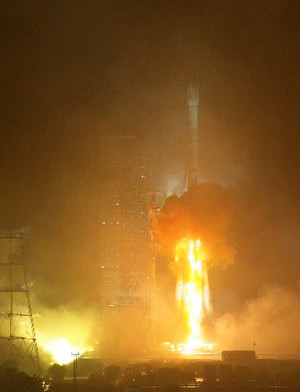Listeners shocked by XM hosts’ suspension
Many cancel the service. Some suspect a proposed merger with Sirius is a factor in the punishment.
By Jim Puzzanghera and Amy Kaufman, Times Staff Writers
May 17, 2007
WASHINGTON — Satellite radio bills itself as the Wild West of the airwaves, an uncensored outpost beyond the reach of federal regulators where expletives fly with impunity and the banter can get as raunchy as at a strip club.
But the decision this week by XM Satellite Radio to suspend shock jocks Opie and Anthony for 30 days for crude sexual comments about First Lady Laura Bush, Secretary of State Condoleezza Rice and Queen Elizabeth II has listeners wondering whether there’s a new sheriff in town.
Some XM listeners were outraged — not at the comments but at XM’s reaction.
"I signed up for XM because it’s uncensored. I like these guys because they are so unfiltered," said Placentia resident Paul Hebert, who canceled his $12.95 monthly XM subscription Tuesday in protest.
He wasn’t alone. Hundreds of angry subscribers have flooded XM’s operators with calls to cancel since the suspension was announced Tuesday. About 60 listeners smashed their XM receivers Wednesday outside the WFNY-FM studios in New York, where Gregg "Opie" Hughes and Anthony Cumia continued to air their tamer, over-the-air broadcast for CBS Radio.
"The reaction is mind-blowing," said Ryan Saghir of North Branford, Conn., who runs a blog about satellite radio called Orbitcast. "One of the main attractors to satellite radio is the unregulated content. Once you take away that … you’re going to have some upset subscribers."
But industry observers said XM might have been more worried about offending federal regulators, who can block the company’s proposed merger with its only rival, Sirius Satellite Radio, than staying true to its slogan, "Beyond AM. Beyond FM. XM."
Sensitivities have been heightened in Washington since the controversy over veteran shock jock Don Imus’ racially offensive comments about the Rutgers University women’s basketball team, which led to his firing last month by CBS Radio.
"It’s hard to read anything into it other than that they’re catering to federal officials," said William Kidd, a media analyst with Wedbush Morgan Securities in Los Angeles.
XM spokesman Nathaniel Brown would not comment on whether the pending merger was a factor in the suspension and would not say how many people had canceled their subscriptions. XM has suspended on-air personalities before, he said, but none with as high a profile as Hughes and Cumia.
It’s not the first time a skit has landed the two shock jocks in trouble. CBS Radio, then known as Infinity Broadcasting, fired them in 2002 for broadcasting two listeners apparently having sex in New York’s St. Patrick’s Cathedral. The Federal Communications Commission fined Infinity $357,000 for the stunt.
XM, which does not fall under the FCC’s indecency rules because it is a pay service, hired Hughes and Cumia in 2004. Their program, "The Opie & Anthony Show," airs from 6 a.m. to 9 a.m. on XM and 24 CBS radio affiliates, which picked the duo back up last year.
It continues until about 11 a.m. only on XM, a segment that the show’s website touts as "uncut, uncensored and totally filthy."
On May 9, the XM portion of the show aired a skit featuring a character called Homeless Charlie, who graphically described having sex with Bush, Rice and the queen. Hughes and Cumia played along, laughing and asking questions.
XM issued a statement condemning the comments, and Cumia and Hughes apologized on the air Friday.
On Monday’s show, Hughes and Cumia complained about "dumb rules" and an "umbrella of morality and decency" that led Imus and some other hosts to get fired. XM officials suspended the pair Tuesday, saying the comments "put into question whether they appreciate the seriousness of the matter."
Satellite radio followers said the suspension was unprecedented. Some XM listeners were stunned and angry when they heard about it.
Ed L. Kelley of Wagoner, Okla., said he spent six hours on the phone Tuesday night trying to cancel. He’s talking to an attorney about a class-action suit, saying that because "The Opie & Anthony Show" appears on one of XM’s "explicit-language" channels, the company has violated its promise to deliver uncensored content.
"These guys make me laugh and they make fun of everybody equally," Kelley said.
Debbie Wolf, co-founder of People Against Censorship, called the suspension "outrageous" and organized the demonstration outside CBS Radio’s studios. Christopher Lewis of Glenmoore, Penn., quickly registered http://www.cancelxm.com , and the message boards there and on other satellite radio sites have filled up with dozens of angry comments.
"I will not support a company that has decided the one true reason they exist no longer matters," wrote one poster on Orbitcast.
Howard Stern, who left traditional radio in 2004 after battling regulators, also weighed in from his new post at Sirius.
"If you want free speech," he told his listeners Wednesday, "walk in a closet and talk to yourself."
Kidd said the suspension could make it difficult for XM to attract edgy radio personalities who have viewed satellite as a haven for their outrageous acts.
"This will probably be a decision that XM will have to live with and, I suspect, likely regret over time," he said.
The suspension would be as surprising as HBO pulling "The Sopranos" for offensive content and will reverberate through the industry, said Tom Taylor, a former program director who edits the trade journal Inside Radio.
"People in the satellite world have felt safe … until this week," he said.






 Editor’s 14 May 2007 note: At this point ASTRO and NextSat should be a few meters apart. Some observers are suggesting that they are kilometers apart. No word from DARPA.
Editor’s 14 May 2007 note: At this point ASTRO and NextSat should be a few meters apart. Some observers are suggesting that they are kilometers apart. No word from DARPA. 
 China’s Sichuan Province just after midnight this morning. The Nigerian paper The Guardian had some of
China’s Sichuan Province just after midnight this morning. The Nigerian paper The Guardian had some of 